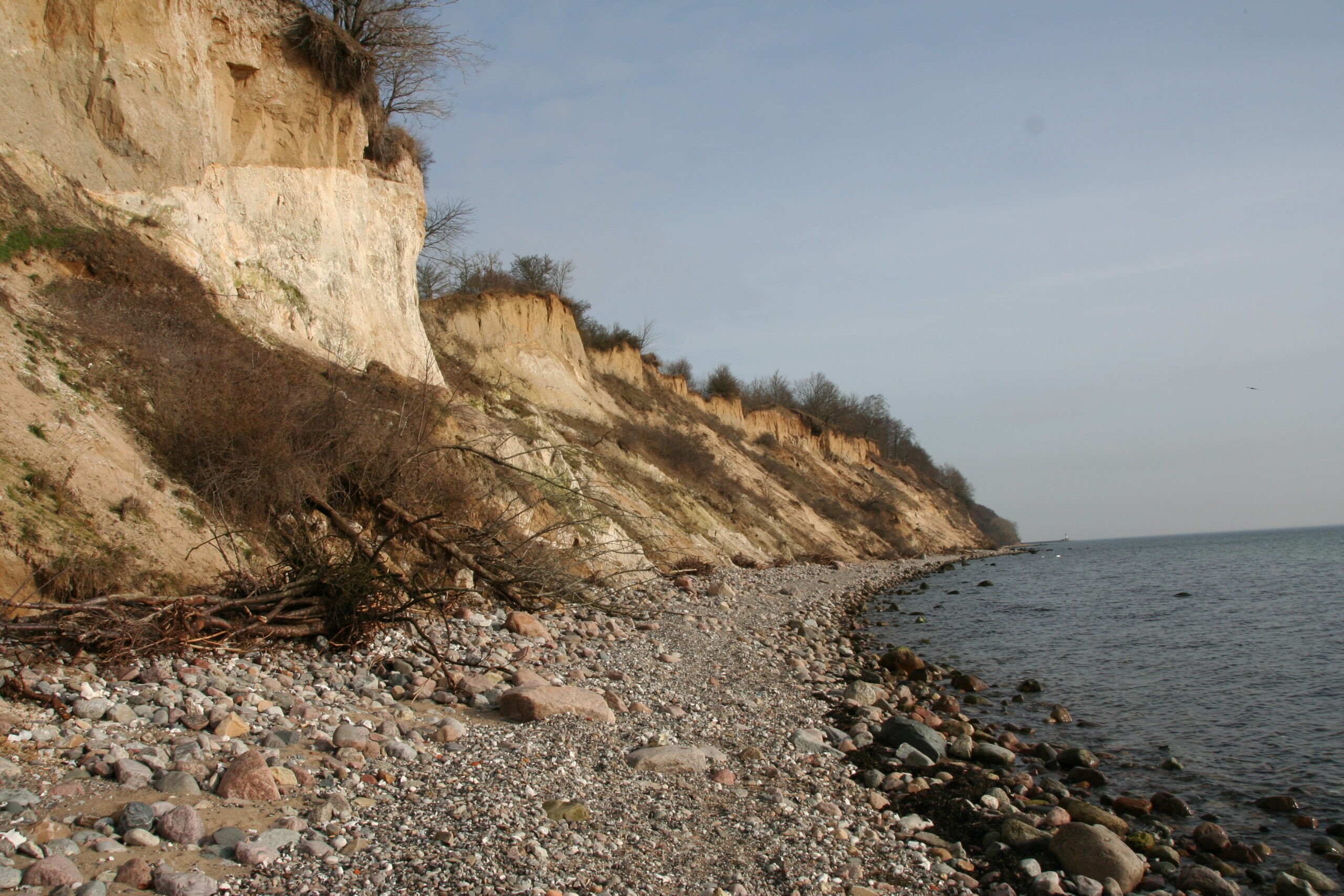Erratic boulders (Geschiebe) – Witnesses of the Ice Age from the North
 There have been several ice ages in the geological past. The most recent glaciation took place in the Pleistocene, when the entire northern area was covered by a blanket of snow and ice similar to today’s conditions in Antarctica.
There have been several ice ages in the geological past. The most recent glaciation took place in the Pleistocene, when the entire northern area was covered by a blanket of snow and ice similar to today’s conditions in Antarctica.
In addition to moraines, outwash plains, oserns and sills, a characteristic legacy of the glaciers are the rocky beaches of the Baltic Sea with their boulder clay cliffs (see above). Characteristic of these deposits is the lack of stratification and the intermixing of all grain sizes from the finest particles to the so-called erratics, which can comprise several cubic metres. A characteristic feature of boulder deposits are glacial scars or so-called kritzer (see below right), which are formed by mutual friction of the rocks during their transport.
Erratic boulders (Geschiebe) research and the neighbouring geoscientific disciplines
The importance of Geschiebes lies mainly in the fact that they are often the only and thus irreplaceable documents of the former cover of Northern Europe. Accordingly, Nordic geology is the main concern of boulder research. Significant parts of the geological history of Baltoscandia and also of northern Germany can only be determined through the study of boulders. The latter also contributes significantly to the expansion of our knowledge about the geology of the Baltic Sea bedrock.
Today’s glaciation areas are also to be included in the studies, whereby the methods developed in the Nordic glaciation area are of particular importance, e.g. for Antarctic research. For this continent, which is almost 98% covered by ice, information about the geological structure and ice movement can be obtained from the boulders deposited on the margins. As the drainage pattern of the Antarctic shows, even there no greater distances occur than have been demonstrated for Nordic debris (up to 1500 km transport distance).
Palaeontology is one of the oldest fields of Geschiebe research. Many fossil groups only became known through Geschiebe findings and some of them have become very important guide fossils (e.g. Chitinozoa, Ostracoda, Trilobita). In addition, there are forms that have not yet been found in the sediment.
In the field of mineralogy and petrography, bedload research has led to the discovery of Europe’s largest copper ore deposit in Outokumou, Finland. Since the distribution of boulders is subject to certain regularities, they are arranged in so-called scatter fans according to the course of the glacier. By tracing such a spreading fan, it is therefore possible to determine the source of a boulder.
Interesting, even if not on an economic scale, are gold finds that are sieved out in gravel washing plants according to the gold-digger mentality. The largest aggregates found so far measure several cm.
Bedload studies on sedimentology and lowland geology comprise two interlocking areas. These are statistical studies on the regional and stratigraphic characterisation of moraines and, in the case of the Rhine, also on river history. In the case of the Rhine, bedload investigations have provided evidence of a course that deviates from the present situation.
Erratic boulders (Geschiebe) research – the mother of Quaternary geology
The beginnings of geschiebe research go far back into the 17th century. As early as 1606, H.R. Räßmann described some moraines in the Swiss area. In the following period, some scientists postulated that a different climate prevailed in the Quaternary. Findings of mammoths and forest elephants are considered as evidence for this. The decisive question about the origin of the rocks was answered by the identification of sedimentary rocks from Mecklenburg and Pomerania with the Orthocerian limestone from southern Sweden. This clarified the home of the bedloads. Von Ahrenswald (1775) proposed a first flood hypothesis for their transport. In 1790, G.A. von Winterfeld postulated the first drift hypothesis, which the Englishman Charles Lyell substantiated in 1835 with the actuality principle. George Cuvier (Georg Küfer) put forward his theory of the rolling stone tide.
The absence of any marine fossils in the boulder clay and the occurrence of large floes (up to 50-80 million m3) rendered both theories implausible. On 3 November 1875, at the meeting of the German Geological Society, the Swede Otto Torell substantiated the inland ice theory on the basis of ice-critched shell limestone from Rüdersdorf near Berlin, which had been examined during a previous excursion. With the finally accepted North-European inland theory, the foundation stone for Quaternary geology was laid, so that bedload research, which finally led to the glacial theory, was named “mother of Quaternary geology”.
For further information on the development of the inland ice theory, please refer to the publication by Karlheinz Kaiser (1975) [Eiszeitalter u. Gegenwart Vol. 26].
